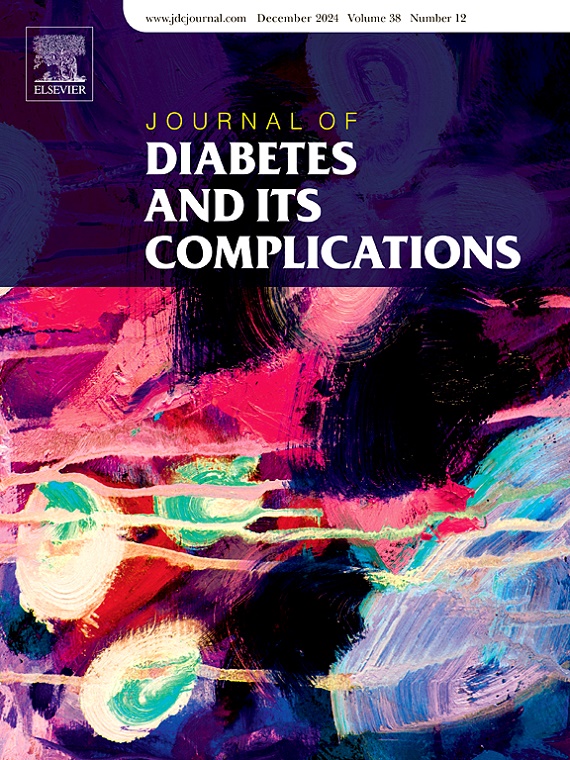Impact of gestational and type 2 diabetes on fetal endothelial cell miRNA expression
IF 3.1
3区 医学
Q3 ENDOCRINOLOGY & METABOLISM
引用次数: 0
Abstract
Aims
Fetal exposure to hyperglycemia in utero have been suggested to induce epigenetic changes through expression of various miRNAs, and cause dysfunctional endothelium connected with elevated risk of cardiovascular disease (CVD) in offspring during early adulthood. In this study, we investigated whether hyperglycemia-induced changes in the expression of 28 fetal endothelial microRNAs (miRNAs) are associated with endothelial dysfunction and CVD.
Methods
Differentially expressed miRNAs in TaqMan miRNA human arrays were quantified using qPCR.
Results
The expression of miR-140-3p, miR-1307-5p, miR-342-3p, and miR-16-5p was significantly reduced in human umbilical vein endothelial cells (HUVECs) from females with gestational diabetes (GDM-UVECs) compared with that of the control group. Meanwhile, in type 2 diabetes (T2D-HUVECs), miR-126-3p and miR-27a-5p were significantly reduced, while miR-27b-3p was significantly increased. Furthermore, miR-29b-3p expression was upregulated in both GDM– and T2D-HUVECs compared with that in the control. The expression of fibroblast growth factor 11 (FGF11) mRNA—a target of dysregulated miR-342-3p—was downregulated in GDMHUVECs compared with that in the control.
Conclusions
Altered miRNA and target FGF11 mRNA expression may contribute mechanistically to endothelial dysfunction in diabetic HUVECs when maintained under normal glucose conditions for several passages.
妊娠期和2型糖尿病对胎儿内皮细胞miRNA表达的影响
研究表明,胎儿在子宫内暴露于高血糖会通过各种mirna的表达诱导表观遗传变化,并导致内皮功能障碍,从而增加后代成年早期心血管疾病(CVD)的风险。在这项研究中,我们研究了高血糖诱导的28种胎儿内皮microRNAs (miRNAs)表达的变化是否与内皮功能障碍和CVD有关。方法采用qPCR技术对TaqMan miRNA人阵列中差异表达的miRNA进行定量分析。结果与对照组相比,妊娠期糖尿病女性脐静脉内皮细胞(GDM-UVECs)中miR-140-3p、miR-1307-5p、miR-342-3p和miR-16-5p的表达显著降低。同时,在2型糖尿病(T2D-HUVECs)中,miR-126-3p和miR-27a-5p显著降低,miR-27b-3p显著升高。此外,与对照组相比,GDM -和t2d - huvec中miR-29b-3p的表达均上调。与对照组相比,gdmhuvec中成纤维细胞生长因子11 (FGF11) mrna (mir -342-3p失调的靶标)的表达下调。结论miRNA和靶FGF11 mRNA表达的减少可能是糖尿病huvec在正常葡萄糖条件下维持数代内皮功能障碍的机制机制。
本文章由计算机程序翻译,如有差异,请以英文原文为准。
求助全文
约1分钟内获得全文
求助全文
来源期刊

Journal of diabetes and its complications
医学-内分泌学与代谢
CiteScore
5.90
自引率
3.30%
发文量
153
审稿时长
16 days
期刊介绍:
Journal of Diabetes and Its Complications (JDC) is a journal for health care practitioners and researchers, that publishes original research about the pathogenesis, diagnosis and management of diabetes mellitus and its complications. JDC also publishes articles on physiological and molecular aspects of glucose homeostasis.
The primary purpose of JDC is to act as a source of information usable by diabetes practitioners and researchers to increase their knowledge about mechanisms of diabetes and complications development, and promote better management of people with diabetes who are at risk for those complications.
Manuscripts submitted to JDC can report any aspect of basic, translational or clinical research as well as epidemiology. Topics can range broadly from early prediabetes to late-stage complicated diabetes. Topics relevant to basic/translational reports include pancreatic islet dysfunction and insulin resistance, altered adipose tissue function in diabetes, altered neuronal control of glucose homeostasis and mechanisms of drug action. Topics relevant to diabetic complications include diabetic retinopathy, neuropathy and nephropathy; peripheral vascular disease and coronary heart disease; gastrointestinal disorders, renal failure and impotence; and hypertension and hyperlipidemia.
 求助内容:
求助内容: 应助结果提醒方式:
应助结果提醒方式:


